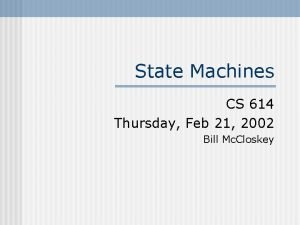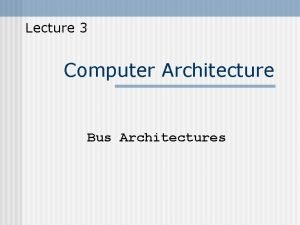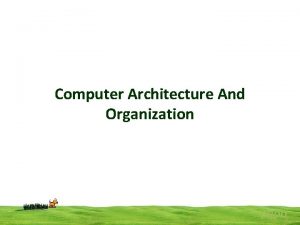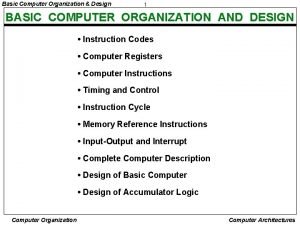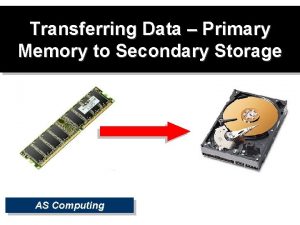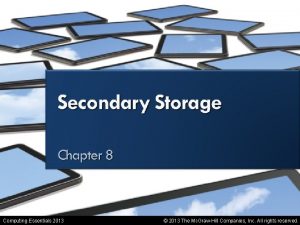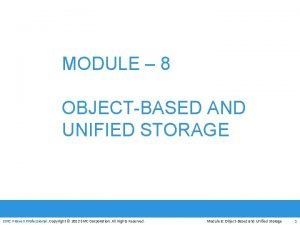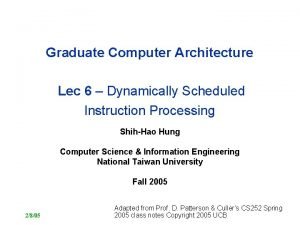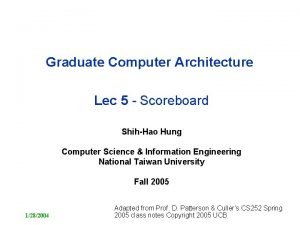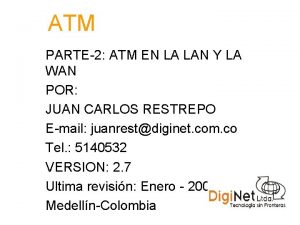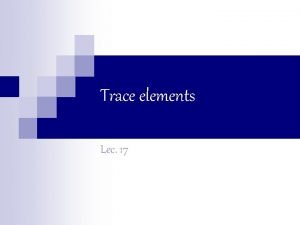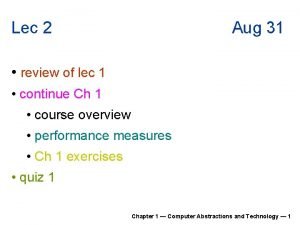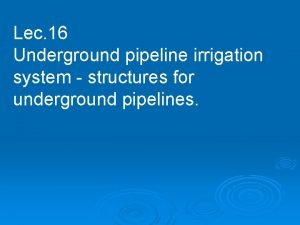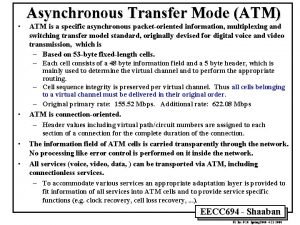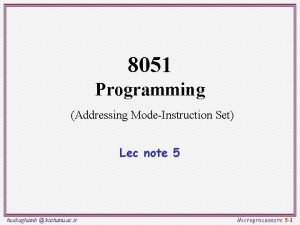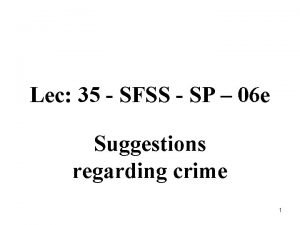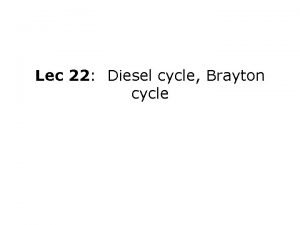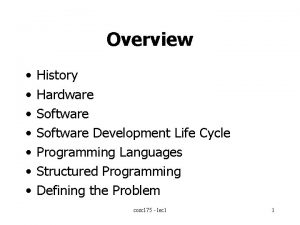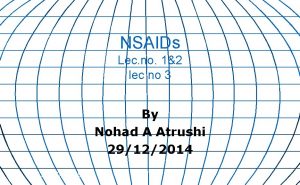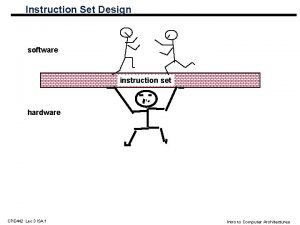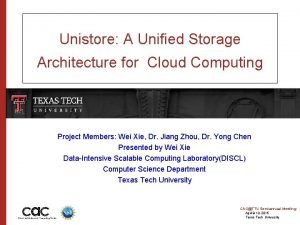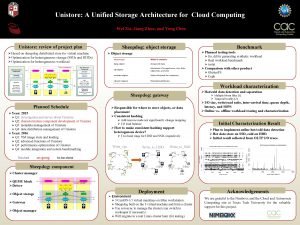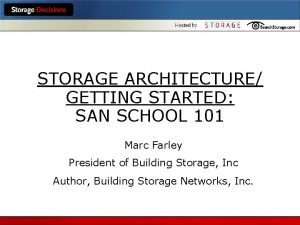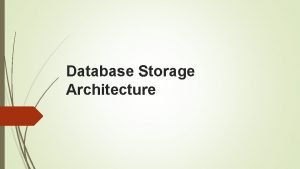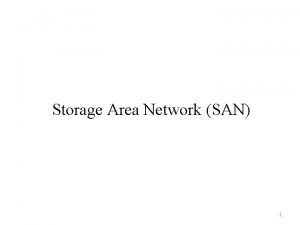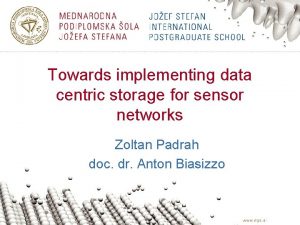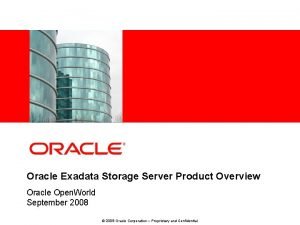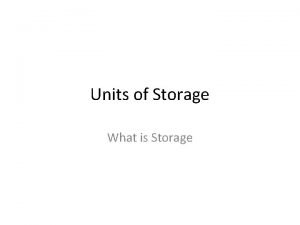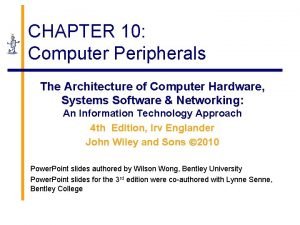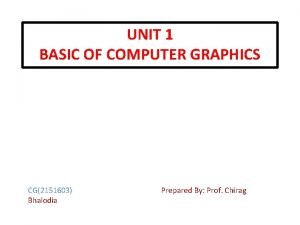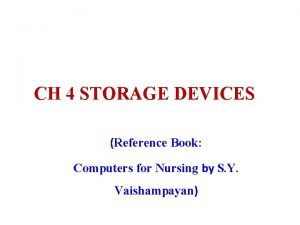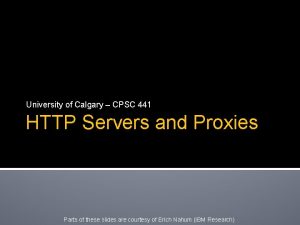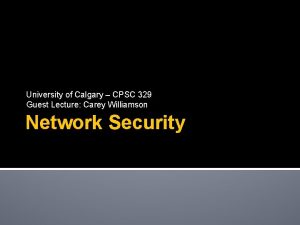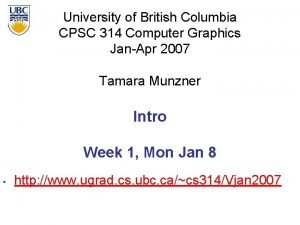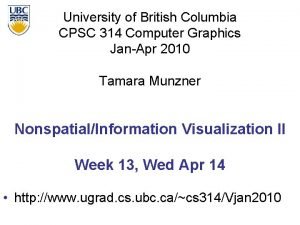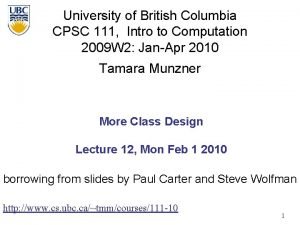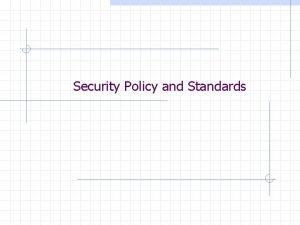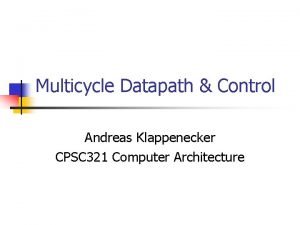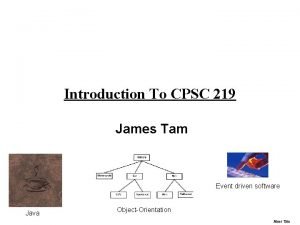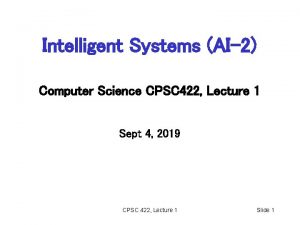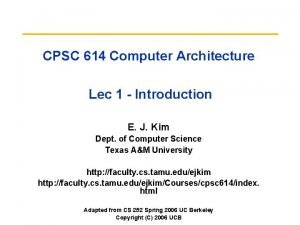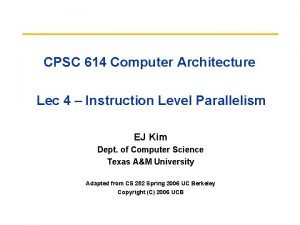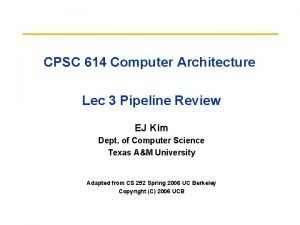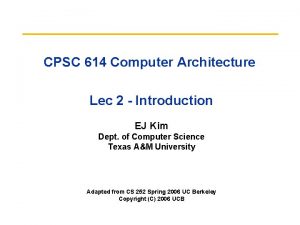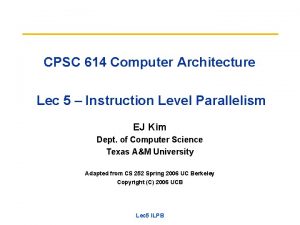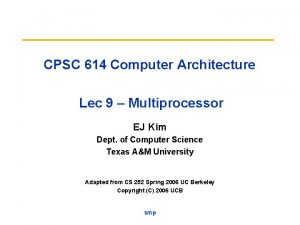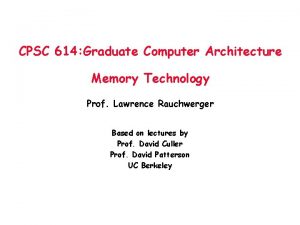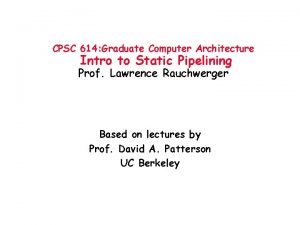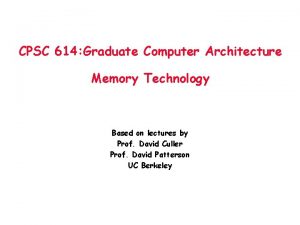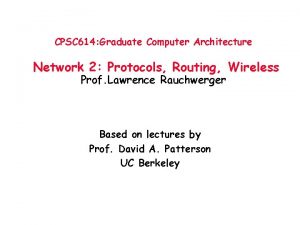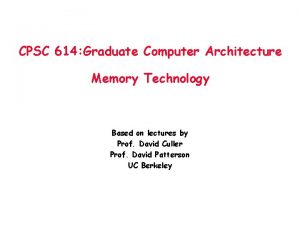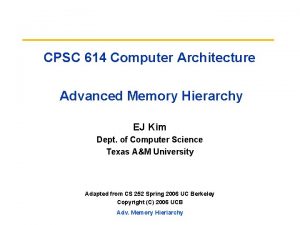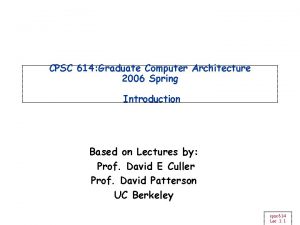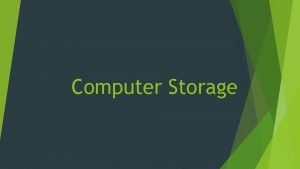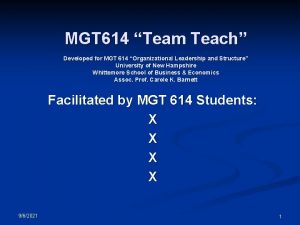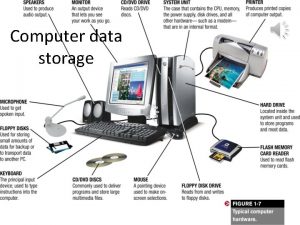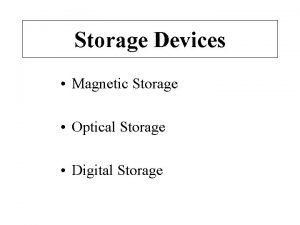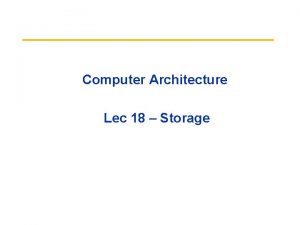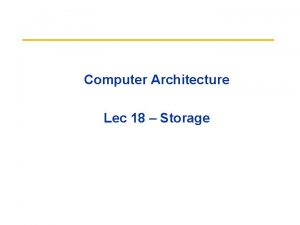CPSC 614 Computer Architecture Lec 18 Storage EJ


















































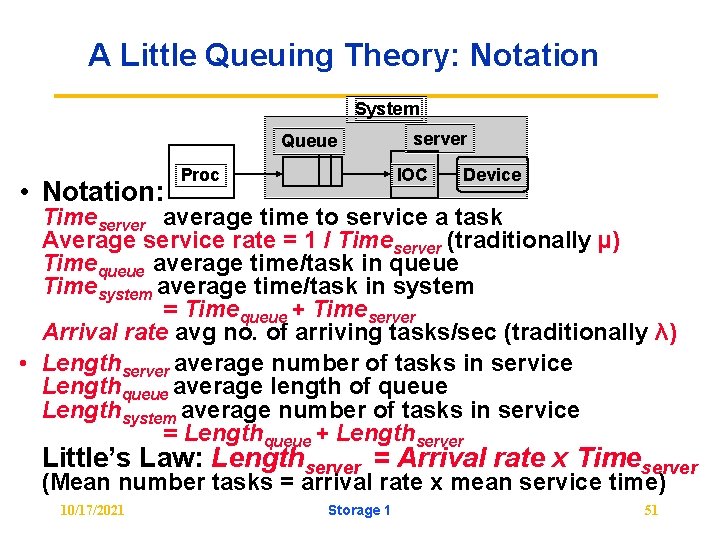
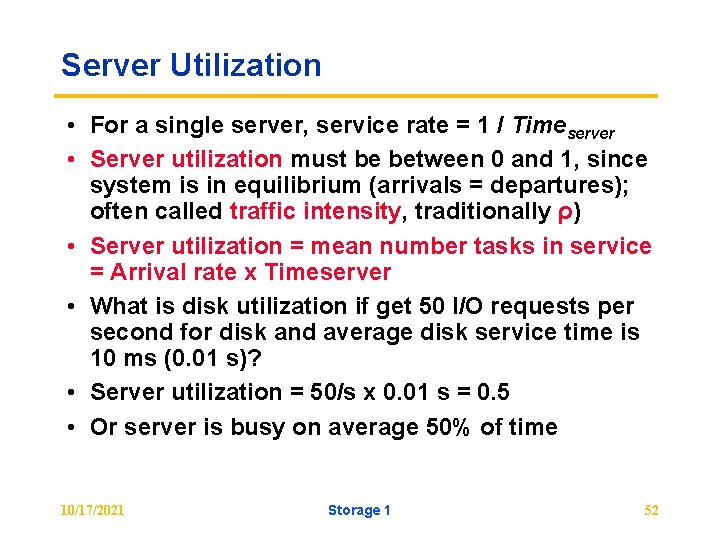
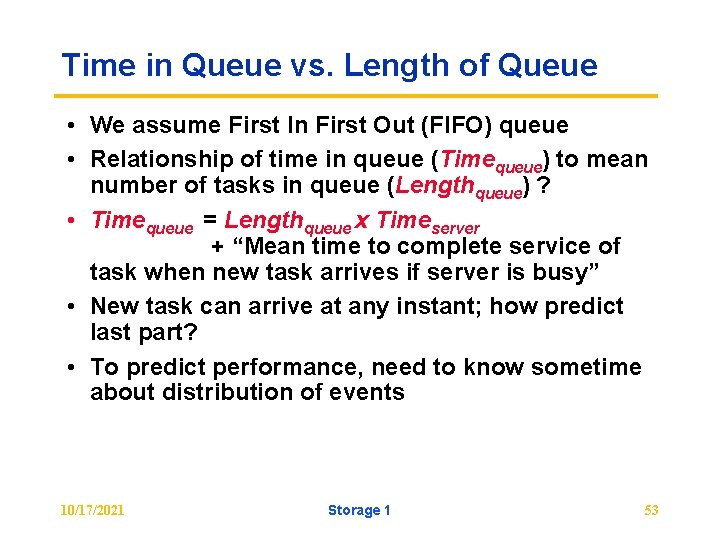
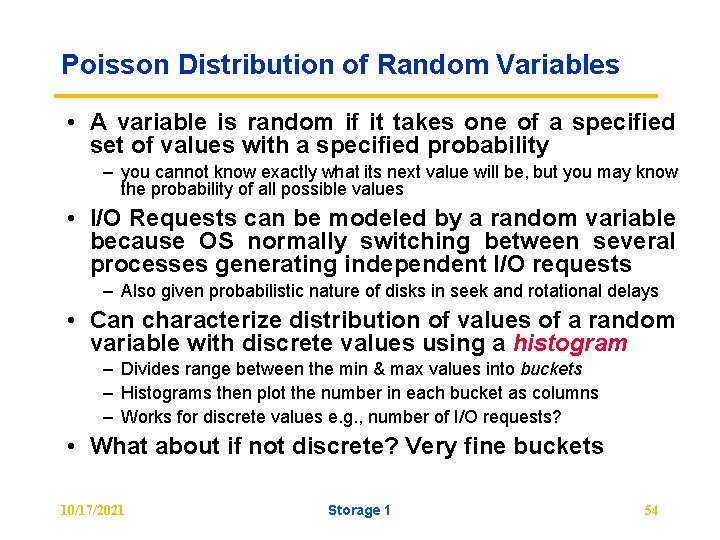
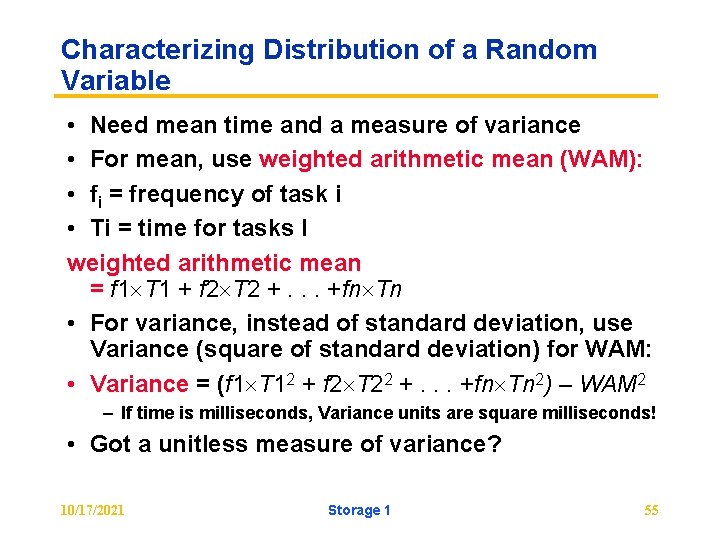
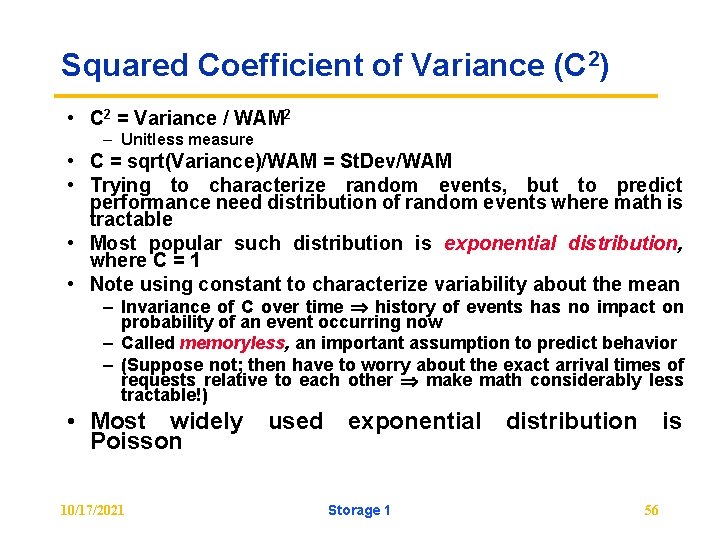
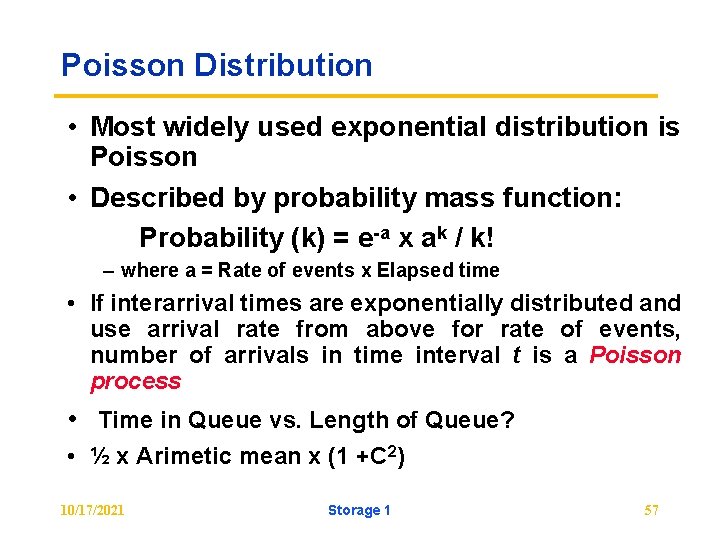
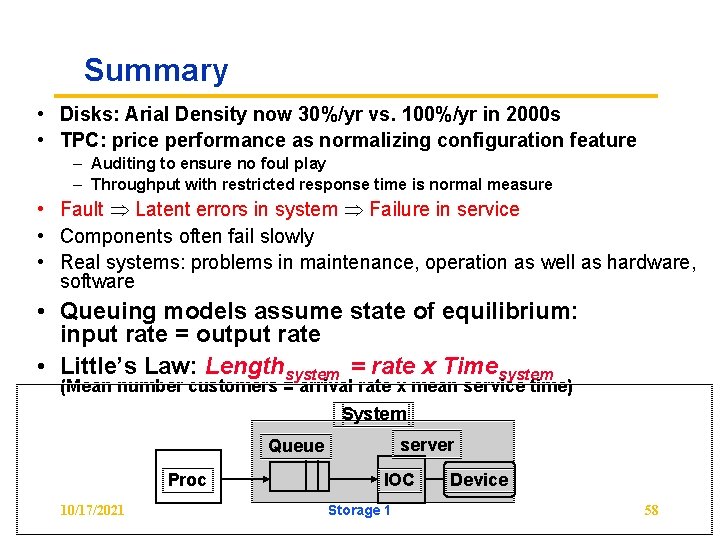
- Slides: 58

CPSC 614 Computer Architecture Lec 18 – Storage EJ Kim Dept. of Computer Science Texas A&M University Storage 1

Review • Virtual Machine Revival – Overcome security flaws of modern OSes – Processor performance no longer highest priority – Manage Software, Manage Hardware • “… VMMs give OS developers another opportunity to develop functionality no longer practical in today’s complex and ossified operating systems, where innovation moves at geologic pace. ” [Rosenblum and Garfinkel, 2005] • Virtualization challenges for processor, virtual memory, I/O – Paravirtualization, ISA upgrades to cope with those difficulties • Xen as example VMM using paravirtualization – 2005 performance on non-I/O bound, I/O intensive apps: 80% of native Linux without driver VM, 34% with driver VM • Opteron memory hierarchy still critical to performance 10/17/2021 Storage 1 2

Case for Storage • Shift in focus from computation to communication and storage of information – E. g. , Cray Research/Thinking Machines vs. Google/Yahoo – “The Computer Revolution” (1960 s to 1980 s) “The Information Age” (1990 to today) • Storage emphasizes reliability and scalability as well as cost-performance • What is “software king” that determines which HW features actually used? – Operating System for storage – Compiler for processor • Also has own performance theory—queuing theory—balances throughput vs. response time 10/17/2021 Storage 1 3

Outline • • • Magnetic Disks RAID Advanced Dependability/Reliability/Availability I/O Benchmarks, Performance and Dependability Intro to Queuing Theory Conclusion 10/17/2021 Storage 1 4

Disk Figure of Merit: Areal Density • Bits recorded along a track – Metric is Bits Per Inch (BPI) • Number of tracks per surface – Metric is Tracks Per Inch (TPI) • Disk designs brag about bit density per unit area – Metric is Bits Per Square Inch: Areal Density = BPI x TPI 10/17/2021 Storage 1 5

Historical Perspective • 1956 IBM Ramac — early 1970 s Winchester – Developed for mainframe computers, proprietary interfaces – Steady shrink in form factor: 27 in. to 14 in. • Form factor and capacity drives market more than performance • 1970 s developments – 5. 25 inch floppy disk form factor (microcode into mainframe) – Emergence of industry standard disk interfaces • Early 1980 s: PCs and first generation workstations • Mid 1980 s: Client/server computing – Centralized storage on file server » accelerates disk downsizing: 8 inch to 5. 25 – Mass market disk drives become a reality » industry standards: SCSI, IPI, IDE » 5. 25 inch to 3. 5 inch drives for PCs, End of proprietary interfaces • 1900 s: Laptops => 2. 5 inch drives • 2000 s: What new devices leading to new drives? 10/17/2021 Storage 1 6

Future Disk Size and Performance • Continued advance in capacity (60%/yr) and bandwidth (40%/yr) • Slow improvement in seek, rotation (8%/yr) – Again, latency improvement less than BW • Time to read whole disk Year Sequentially Randomly (1 sector/seek) 1990 4 minutes 6 hours 2000 12 minutes 1 week (!) 2006 56 minutes 3 weeks (SCSI) 2006 171 minutes 7 weeks (SATA) 10/17/2021 Storage 1 7

Use Arrays of Small Disks? • Katz and Patterson asked in 1987: – Can smaller disks be used to close gap in performance between disks and CPUs? Conventional: 4 disk 3. 5” 5. 25” designs Low End 10” 14” High End Disk Array: 1 disk design 3. 5” 10/17/2021 Storage 1 8

Advantages of Small Form Factor Disk Drives Low cost/MB High MB/volume High MB/watt Low cost/Actuator Cost and Environmental Efficiencies 10/17/2021 Storage 1 9

Replace Small Number of Large Disks with Large Number of Small Disks! (1988 Disks) IBM 3390 K IBM 3. 5" 0061 x 70 20 GB 320 MB 23 GB Capacity 97 ft 3 0. 1 ft 3 11 ft 3 9 X Volume 3 k. W 11 W 1 k. W 3 X Power 15 MB/s 120 MB/s 8 X Data Rate 600 I/O/s 55 I/O/s 3900 IO/s 6 X I/O Rate 250 KHrs ? ? ? Hrs MTTF $250 K $2 K $150 K Cost Disk Arrays have potential for large data, I/O rates, MB/ft 3, MB/k. W, but what about reliability? 10/17/2021 Storage 1 10

Array Reliability • Reliability of N disks = Reliability of 1 Disk ÷ N 50, 000 Hours ÷ 70 disks = 700 hours Disk system MTTF: Drops from 6 years to 1 month! • Arrays (without redundancy) too unreliable to be useful! Hot spares support reconstruction in parallel with access: very high media availability can be achieved 10/17/2021 Storage 1 11

Redundant Arrays of (Inexpensive) Disks • Files are "striped" across multiple disks • Redundancy yields high data availability – Availability: service still provided to user, even if some components failed • Disks will still fail – MTTF ~1 M hours for current disks • Contents reconstructed from data redundantly stored in the array Capacity penalty to store redundant info Bandwidth penalty to update redundant info 10/17/2021 Storage 1 12

Redundant Arrays of Inexpensive Disks RAID 1: Disk Mirroring/Shadowing recovery group • Each disk is fully duplicated onto its “mirror” – Very high availability can be achieved • Bandwidth sacrifice on write: – Logical write = two physical writes – Reads may be optimized • Most expensive solution: 100% capacity overhead • (RAID 2 not interesting, so skip) 10/17/2021 Storage 1 13

Redundant Array of Inexpensive Disks RAID 3: Parity Disk 10010011 11001101 10010011. . . logical record P 1 1 0 1 Striped physical 1 0 records 0 0 P contains sum of 0 1 other disks per stripe 0 1 mod 2 (“parity”) 1 0 If disk fails, subtract 1 1 P from sum of other disks to find missing information 10/17/2021 Storage 1 1 0 0 0 1 14

RAID 3 • Sum computed across recovery group to protect against hard disk failures, stored in P disk • Logically, a single high capacity, high transfer rate disk: good for large transfers • Wider arrays reduce capacity costs, but decreases availability • 33% capacity cost for parity if 3 data disks and 1 parity disk 10/17/2021 Storage 1 15

Inspiration for RAID 4 • RAID 3 relies on parity disk to discover errors on Read • But every sector has an error detection field • To catch errors on read, rely on error detection field vs. the parity disk • Allows independent reads to different disks simultaneously 10/17/2021 Storage 1 16

Redundant Arrays of Inexpensive Disks RAID 4: High I/O Rate Parity Increasing Insides of 5 disks Example: small read D 0 & D 5, large write D 12 -D 15 10/17/2021 D 0 D 1 D 2 D 3 P D 4 D 5 D 6 D 7 P D 8 D 9 D 10 D 11 P D 12 D 13 D 14 D 15 P D 16 D 17 D 18 D 19 P D 20 D 21 D 22 D 23 P . . . Disk Columns. Storage 1. . . . Logical Disk Address Stripe 17

Inspiration for RAID 5 • RAID 4 works well for small reads • Small writes (write to one disk): – Option 1: read other data disks, create new sum and write to Parity Disk – Option 2: since P has old sum, compare old data to new data, add the difference to P • Small writes are limited by Parity Disk: Write to D 0, D 5 both also write to P disk 10/17/2021 D 0 D 1 D 2 D 3 P D 4 D 5 D 6 D 7 P Storage 1 18

Redundant Arrays of Inexpensive Disks RAID 5: High I/O Rate Interleaved Parity Independent writes possible because of interleaved parity Example: write to D 0, D 5 uses disks 0, 1, 3, 4 10/17/2021 D 0 D 1 D 2 D 3 P D 4 D 5 D 6 P D 7 D 8 D 9 P D 10 D 11 D 12 P D 13 D 14 D 15 P D 16 D 17 D 18 D 19 D 20 D 21 D 22 D 23 P . . . . Disk Columns. . Storage 1. . . Increasing Logical Disk Addresses 19

Problems of Disk Arrays: Small Writes RAID-5: Small Write Algorithm 1 Logical Write = 2 Physical Reads + 2 Physical Writes D 0' new data D 0 D 1 D 2 D 3 old data (1. Read) P old (2. Read) parity + XOR (3. Write) 10/17/2021 D 0' D 1 (4. Write) D 2 Storage 1 D 3 P' 20

RAID 6: Recovering from 2 failures • Why > 1 failure recovery? – operator accidentally replaces the wrong disk during a failure – since disk bandwidth is growing more slowly than disk capacity, the MTT Repair a disk in a RAID system is increasing increases the chances of a 2 nd failure during repair since takes longer – reading much more data during reconstruction meant increasing the chance of an uncorrectable media failure, which would result in data loss 10/17/2021 Storage 1 21

RAID 6: Recovering from 2 failures • Network Appliance’s row-diagonal parity or RAID -DP • Like the standard RAID schemes, it uses redundant space based on parity calculation per stripe • Since it is protecting against a double failure, it adds two check blocks per stripe of data. – If p+1 disks total, p-1 disks have data; assume p=5 • Row parity disk is just like in RAID 4 – Even parity across the other 4 data blocks in its stripe • Each block of the diagonal parity disk contains the even parity of the blocks in the same diagonal 10/17/2021 Storage 1 22

Example p = 5 • Row diagonal parity starts by recovering one of the 4 blocks on the failed disk using diagonal parity – Since each diagonal misses one disk, and all diagonals miss a different disk, 2 diagonals are only missing 1 block • Once the data for those blocks is recovered, then the standard RAID recovery scheme can be used to recover two more blocks in the standard RAID 4 stripes • Process continues until two failed disks are restored 10/17/2021 Data Disk 0 Data Disk 1 Data Disk 2 Data Disk 3 Row Parity Diagona l Parity 0 1 2 3 4 0 1 2 3 4 0 Storage 1 23

Berkeley History: RAID-I • RAID-I (1989) – Sun 4/280 workstation with 128 MB of DRAM, four dual-string SCSI controllers, 28 5. 25 -inch SCSI disks and specialized disk striping software • Today RAID is $24 B industry, 80% non-PC disks sold in RAIDs 10/17/2021 Storage 1 24

Summary: RAID Goal was performance, popularity due to reliability of storage • Disk Mirroring, Shadowing (RAID 1) Each disk is fully duplicated onto its "shadow" Logical write = two physical writes 100% capacity overhead • Parity Data Bandwidth Array (RAID 3) Parity computed horizontally Logically a single high data bw disk • High I/O Rate Parity Array (RAID 5) 1 0 0 1 1 1 0 0 1 1 0 0 1 0 Interleaved parity blocks Independent reads and writes Logical write = 2 reads + 2 writes 10/17/2021 Storage 1 25

Definitions • Examples on why precise definitions so important for reliability • Is a programming mistake a fault, error, or failure? – Are we talking about the time it was designed or the time the program is run? – If the running program doesn’t exercise the mistake, is it still a fault/error/failure? • If an alpha particle hits a DRAM memory cell, is it a fault/error/failure if it doesn’t change the value? – Is it a fault/error/failure if the memory doesn’t access the changed bit? – Did a fault/error/failure still occur if the memory had error correction and delivered the corrected value to the CPU? 10/17/2021 Storage 1 26

IFIP Standard terminology • Computer system dependability: quality of delivered service such that reliance can be placed on service • Service is observed actual behavior as perceived by other system(s) interacting with this system’s users • Each module has ideal specified behavior, where service specification is agreed description of expected behavior • A system failure occurs when the actual behavior deviates from the specified behavior • failure occurred because an error, a defect in module • The cause of an error is a fault • When a fault occurs it creates a latent error, which becomes effective when it is activated • When error actually affects the delivered service, a failure 27 occurs (time from error to failure is error latency)

Fault v. (Latent) Error v. Failure • An error is manifestation in the system of a fault, a failure is manifestation on the service of an error • Is If an alpha particle hits a DRAM memory cell, is it a fault/error/failure if it doesn’t change the value? – Is it a fault/error/failure if the memory doesn’t access the changed bit? – Did a fault/error/failure still occur if the memory had error correction and delivered the corrected value to the CPU? • • An alpha particle hitting a DRAM can be a fault if it changes the memory, it creates an error remains latent until effected memory word is read if the effected word error affects the delivered service, a failure occurs 10/17/2021 Storage 1 28

Fault Categories 1. Hardware faults: Devices that fail, such alpha particle hitting a memory cell 2. Design faults: Faults in software (usually) and hardware design (occasionally) 3. Operation faults: Mistakes by operations and maintenance personnel 4. Environmental faults: Fire, flood, earthquake, power failure, and sabotage • Also by duration: 1. Transient faults exist for limited time and not recurring 2. Intermittent faults cause a system to oscillate between faulty and fault-free operation 3. Permanent faults do not correct themselves over time 10/17/2021 Storage 1 29

Fault Tolerance vs Disaster Tolerance • Fault-Tolerance (or more properly, Error. Tolerance): mask local faults (prevent errors from becoming failures) – RAID disks – Uninterruptible Power Supplies – Cluster Failover • Disaster Tolerance: masks site errors (prevent site errors from causing service failures) – Protects against fire, flood, sabotage, . . – Redundant system and service at remote site. – Use design diversity From Jim Gray’s “Talk at UC Berkeley on Fault Tolerance " 11/9/00 10/17/2021 Storage 1 30

Case Studies - Tandem Trends Reported MTTF by Component SOFTWARE HARDWARE MAINTENANCE OPERATIONS ENVIRONMENT 1985 2 29 45 99 142 1987 53 91 162 171 214 1990 33 310 409 136 346 Years Years SYSTEM 8 20 21 Problem: Systematic Under-reporting From Jim Gray’s “Talk at UC Berkeley on Fault Tolerance " 11/9/00 10/17/2021 Storage 1 Years 31

Is Maintenance the Key? • Rule of Thumb: Maintenance 10 X HW Cost – so over 5 year product life, ~ 95% of cost is maintenance • VAX crashes ‘ 85, ‘ 93 [Murp 95]; extrapolate to ‘ 01 • Sys. Man. : N crashes/problem, Sys. Admin action – Actions: set params bad, bad config, bad app install • HW/OS 70% in ‘ 85 to 28% in ‘ 93. In ‘ 01, 10%? 10/17/2021 Storage 1 32

HW Failures in Real Systems: Tertiary Disks A cluster of 20 PCs in seven 7 -ft high, 19 -in wide racks with 368 8. 4 -GB, 7200 RPM, 3. 5 -in IBM disks. The PCs are P 6 -200 MHz with 96 MB of DRAM each. They run Free. BSD 3. 0 and the hosts are connected via switched 100 Mbps Ethernet 10/17/2021 Storage 1 33

Does Hardware Fail Fast? 4 of 384 Disks that failed in Tertiary Disk 10/17/2021 Storage 1 34

High Availability System Classes Goal: Build Class 6 Systems Unavailable System Type (min/year) Unmanaged 50, 000 Managed 5, 000 Well Managed 500 Fault Tolerant 50 High-Availability 5 Very-High-Availability. 5 Ultra-Availability. 05 Availability Class 90. % 99. 9% 99. 999% 99. 99999% 1 2 3 4 5 6 7 Un. Availability = MTTR/MTBF can cut it in ½ by cutting MTTR or MTBF From Jim Gray’s “Talk at UC Berkeley on Fault Tolerance " 11/9/00 10/17/2021 Storage 1 35

How Realistic is "5 Nines"? • HP claims HP-9000 server HW and HP-UX OS can deliver 99. 999% availability guarantee “in certain pre -defined, pre-tested customer environments” – Application faults? – Operator faults? – Environmental faults? • Co-location sites (lots of computers in 1 building on Internet) have – 1 network outage per year (~1 day) – 1 power failure per year (~1 day) • Microsoft Network unavailable recently for a day due to problem in Domain Name Server: if only outage per year, 99. 7% or 2 Nines 10/17/2021 Storage 1 36

Outline • • • Magnetic Disks RAID Advanced Dependability/Reliability/Availability I/O Benchmarks, Performance and Dependability Intro to Queueing Theory (if we have time) Conclusion 10/17/2021 Storage 1 37

I/O Performance 300 Metrics: Response Time vs. Throughput Response Time (ms) 200 100 0 0% 100% Throughput (% total BW) Queue Proc IOC Device Response time = Queue + Device Service time 10/17/2021 Storage 1 38

I/O Benchmarks • For better or worse, benchmarks shape a field – Processor benchmarks classically aimed at response time for fixed sized problem – I/O benchmarks typically measure throughput, possibly with upper limit on response times (or 90% of response times) • Transaction Processing (TP) (or On-line TP=OLTP) – If bank computer fails when customer withdraw money, TP system guarantees account debited if customer gets $ & account unchanged if no $ – Airline reservation systems & banks use TP • Atomic transactions makes this work • Classic metric is Transactions Per Second (TPS) 10/17/2021 Storage 1 39

I/O Benchmarks: Transaction Processing • Early 1980 s great interest in OLTP – Expecting demand for high TPS (e. g. , ATM machines, credit cards) – Tandem’s success implied medium range OLTP expands – Each vendor picked own conditions for TPS claims, report only CPU times with widely different I/O – Conflicting claims led to disbelief of all benchmarks chaos • 1984 Jim Gray (Tandem) distributed paper to Tandem + 19 in other companies propose standard benchmark • Published “A measure of transaction processing power, ” Datamation, 1985 by Anonymous et. al – To indicate that this was effort of large group – To avoid delays of legal department of each author’s firm – Still get mail at Tandem to author “Anonymous” • Led to Transaction Processing Council in 1988 – www. tpc. org 10/17/2021 Storage 1 40

I/O Benchmarks: TP 1 by Anon et. al • Debit. Credit Scalability: size of account, branch, teller, history function of throughput TPS Number of ATMs Account-file size 10 1, 000 0. 1 GB 100 10, 000 1. 0 GB 1, 000 100, 000 10. 0 GB 10, 000 1, 000 100. 0 GB – Each input TPS =>100, 000 account records, 10 branches, 100 ATMs – Accounts must grow since a person is not likely to use the bank more frequently just because the bank has a faster computer! • Response time: 95% transactions take ≤ 1 second • Report price (initial purchase price + 5 year maintenance = cost of ownership) • Hire auditor to certify results 10/17/2021 Storage 1 41

Unusual Characteristics of TPC • Price is included in the benchmarks – cost of HW, SW, and 5 -year maintenance agreements included price-performance as well as performance • The data set generally must scale in size as the throughput increases – trying to model real systems, demand on system and size of the data stored in it increase together • The benchmark results are audited – Must be approved by certified TPC auditor, who enforces TPC rules only fair results are submitted • Throughput is the performance metric but response times are limited – eg, TPC-C: 90% transaction response times < 5 seconds • An independent organization maintains the benchmarks – COO ballots on changes, meetings, to settle disputes. . . 10/17/2021 Storage 1 42

TPC Benchmark History/Status 10/17/2021 Storage 1 43

I/O Benchmarks via SPEC • SFS 3. 0 Attempt by NFS companies to agree on standard benchmark – – – Run on multiple clients & networks (to prevent bottlenecks) Same caching policy in all clients Reads: 85% full block & 15% partial blocks Writes: 50% full block & 50% partial blocks Average response time: 40 ms Scaling: for every 100 NFS ops/sec, increase capacity 1 GB • Results: plot of server load (throughput) vs. response time & number of users – Assumes: 1 user => 10 NFS ops/sec – 3. 0 for NSF 3. 0 • Added SPECMail (mailserver), SPECWeb (webserver) benchmarks 10/17/2021 Storage 1 44

2005 Example SPEC SFS Result: Net. App FAS 3050 c NFS servers • 2. 8 GHz Pentium Xeon microprocessors, 2 GB of DRAM per processor, 1 GB of Non-volatile memory per system • 4 FDDI networks; 32 NFS Daemons, 24 GB file size • 168 fibre channel disks: 72 GB, 15000 RPM, 2 or 4 FC controllers 10/17/2021 Storage 1 45

Availability Benchmark Methodology • Goal: quantify variation in Qo. S metrics as events occur that affect system availability • Leverage existing performance benchmarks – to generate fair workloads – to measure & trace quality of service metrics • Use fault injection to compromise system – hardware faults (disk, memory, network, power) – software faults (corrupt input, driver error returns) – maintenance events (repairs, SW/HW upgrades) • Examine single-fault and multi-fault workloads – the availability analogues of performance micro- and macrobenchmarks 10/17/2021 Storage 1 46

Example Single-Fault Result Linux Solaris • Compares Linux and Solaris reconstruction – Linux: minimal performance impact but longer window of vulnerability to second fault – Solaris: large performance impact but restores redundancy fast 10/17/2021 Storage 1 47

Reconstruction policy (2) • Linux: favors performance over data availability – automatically-initiated reconstruction, idle bandwidth – virtually no performance impact on application – very long window of vulnerability (>1 hr for 3 GB RAID) • Solaris: favors data availability over app. perf. – automatically-initiated reconstruction at high BW – as much as 34% drop in application performance – short window of vulnerability (10 minutes for 3 GB) • Windows: favors neither! – manually-initiated reconstruction at moderate BW – as much as 18% app. performance drop – somewhat short window of vulnerability (23 min/3 GB) 10/17/2021 Storage 1 48

Introduction to Queuing Theory Arrivals Departures • More interested in long term, steady state than in startup => Arrivals = Departures • Little’s Law: Mean number tasks in system = arrival rate x mean reponse time – Observed by many, Little was first to prove • Applies to any system in equilibrium, as long as black box not creating or destroying tasks 10/17/2021 Storage 1 49

Deriving Little’s Law • Timeobserve = elapsed time that observe a system • Numbertask = number of task during Timeobserve • Timeaccumulated = sum of elapsed times for each task Then • Mean number tasks in system = Timeaccumulated / Timeobserve • Mean response time = Timeaccumulated / Numbertask • Arrival Rate = Numbertask / Timeobserve Factoring RHS of 1 st equation • Timeaccumulated / Timeobserve = Timeaccumulated / Numbertask x Numbertask / Timeobserve Then get Little’s Law: • Mean number tasks in system = Arrival Rate x Mean response time 10/17/2021 Storage 1 50

A Little Queuing Theory: Notation System Queue • Notation: Proc server IOC Device Timeserver average time to service a task Average service rate = 1 / Timeserver (traditionally µ) Timequeue average time/task in queue Timesystem average time/task in system = Timequeue + Timeserver Arrival rate avg no. of arriving tasks/sec (traditionally λ) • Lengthserver average number of tasks in service Lengthqueue average length of queue Lengthsystem average number of tasks in service = Lengthqueue + Lengthserver Little’s Law: Lengthserver = Arrival rate x Timeserver (Mean number tasks = arrival rate x mean service time) 10/17/2021 Storage 1 51

Server Utilization • For a single server, service rate = 1 / Timeserver • Server utilization must be between 0 and 1, since system is in equilibrium (arrivals = departures); often called traffic intensity, traditionally ρ) • Server utilization = mean number tasks in service = Arrival rate x Timeserver • What is disk utilization if get 50 I/O requests per second for disk and average disk service time is 10 ms (0. 01 s)? • Server utilization = 50/s x 0. 01 s = 0. 5 • Or server is busy on average 50% of time 10/17/2021 Storage 1 52

Time in Queue vs. Length of Queue • We assume First In First Out (FIFO) queue • Relationship of time in queue (Timequeue) to mean number of tasks in queue (Lengthqueue) ? • Timequeue = Lengthqueue x Timeserver + “Mean time to complete service of task when new task arrives if server is busy” • New task can arrive at any instant; how predict last part? • To predict performance, need to know sometime about distribution of events 10/17/2021 Storage 1 53

Poisson Distribution of Random Variables • A variable is random if it takes one of a specified set of values with a specified probability – you cannot know exactly what its next value will be, but you may know the probability of all possible values • I/O Requests can be modeled by a random variable because OS normally switching between several processes generating independent I/O requests – Also given probabilistic nature of disks in seek and rotational delays • Can characterize distribution of values of a random variable with discrete values using a histogram – Divides range between the min & max values into buckets – Histograms then plot the number in each bucket as columns – Works for discrete values e. g. , number of I/O requests? • What about if not discrete? Very fine buckets 10/17/2021 Storage 1 54

Characterizing Distribution of a Random Variable • Need mean time and a measure of variance • For mean, use weighted arithmetic mean (WAM): • fi = frequency of task i • Ti = time for tasks I weighted arithmetic mean = f 1 T 1 + f 2 T 2 +. . . +fn Tn • For variance, instead of standard deviation, use Variance (square of standard deviation) for WAM: • Variance = (f 1 T 12 + f 2 T 22 +. . . +fn Tn 2) – WAM 2 – If time is milliseconds, Variance units are square milliseconds! • Got a unitless measure of variance? 10/17/2021 Storage 1 55

Squared Coefficient of Variance (C 2) • C 2 = Variance / WAM 2 – Unitless measure • C = sqrt(Variance)/WAM = St. Dev/WAM • Trying to characterize random events, but to predict performance need distribution of random events where math is tractable • Most popular such distribution is exponential distribution, where C = 1 • Note using constant to characterize variability about the mean – Invariance of C over time history of events has no impact on probability of an event occurring now – Called memoryless, an important assumption to predict behavior – (Suppose not; then have to worry about the exact arrival times of requests relative to each other make math considerably less tractable!) • Most widely used exponential distribution is Poisson 10/17/2021 Storage 1 56

Poisson Distribution • Most widely used exponential distribution is Poisson • Described by probability mass function: Probability (k) = e-a x ak / k! – where a = Rate of events x Elapsed time • If interarrival times are exponentially distributed and use arrival rate from above for rate of events, number of arrivals in time interval t is a Poisson process • Time in Queue vs. Length of Queue? • ½ x Arimetic mean x (1 +C 2) 10/17/2021 Storage 1 57

Summary • Disks: Arial Density now 30%/yr vs. 100%/yr in 2000 s • TPC: price performance as normalizing configuration feature – Auditing to ensure no foul play – Throughput with restricted response time is normal measure • Fault Latent errors in system Failure in service • Components often fail slowly • Real systems: problems in maintenance, operation as well as hardware, software • Queuing models assume state of equilibrium: input rate = output rate • Little’s Law: Lengthsystem = rate x Timesystem (Mean number customers = arrival rate x mean service time) System server Queue Proc 10/17/2021 IOC Storage 1 Device 58
 Cs 614
Cs 614 914-614-3221
914-614-3221 Bus design in computer architecture
Bus design in computer architecture Diff between computer organization and architecture
Diff between computer organization and architecture Basic computer design
Basic computer design Secondary storage vs primary storage
Secondary storage vs primary storage Primary storage and secondary storage
Primary storage and secondary storage Uses rigid metallic platters
Uses rigid metallic platters Object based and unified storage
Object based and unified storage Scoreboard computer architecture
Scoreboard computer architecture 11th chemistry thermodynamics lec 13
11th chemistry thermodynamics lec 13 Lec ditto
Lec ditto Lec scoreboard
Lec scoreboard Componentes del lec
Componentes del lec 11th chemistry thermodynamics lec 10
11th chemistry thermodynamics lec 10 Elements lec
Elements lec August lec 250
August lec 250 Underground pipeline irrigation system
Underground pipeline irrigation system Lec 1
Lec 1 Art 455 lec
Art 455 lec Lec
Lec 132000 lec
132000 lec Lec@b@ret
Lec@b@ret Tipos de lec
Tipos de lec Sekisui slec
Sekisui slec 416 lec
416 lec Lec
Lec Brayton
Brayton Lec promotion
Lec promotion Lec anatomia
Lec anatomia Lec hardver
Lec hardver Fenemates
Fenemates Lecsl
Lecsl Lec hardver
Lec hardver Lec renal
Lec renal 252 lec
252 lec Unified storage architecture
Unified storage architecture Unified storage architecture
Unified storage architecture San storage architecture
San storage architecture Database storage architecture
Database storage architecture Nas fiber channel
Nas fiber channel Data-centric storage
Data-centric storage Exadata image
Exadata image What are storage device
What are storage device Computer memory for short term storage
Computer memory for short term storage Computer peripherals storage devices
Computer peripherals storage devices Dvst stands for in computer graphics
Dvst stands for in computer graphics Optical disc
Optical disc Ubc cpsc 404
Ubc cpsc 404 Cpsc 329 u of c
Cpsc 329 u of c Cpsc 441 u of c
Cpsc 441 u of c Cpsc 329 u of c
Cpsc 329 u of c Cpsc 314 ubc
Cpsc 314 ubc Cpsc 314
Cpsc 314 Cpsc 111
Cpsc 111 Cpsc 449
Cpsc 449 Andreas klappenecker
Andreas klappenecker James tam
James tam Cpsc 422
Cpsc 422
